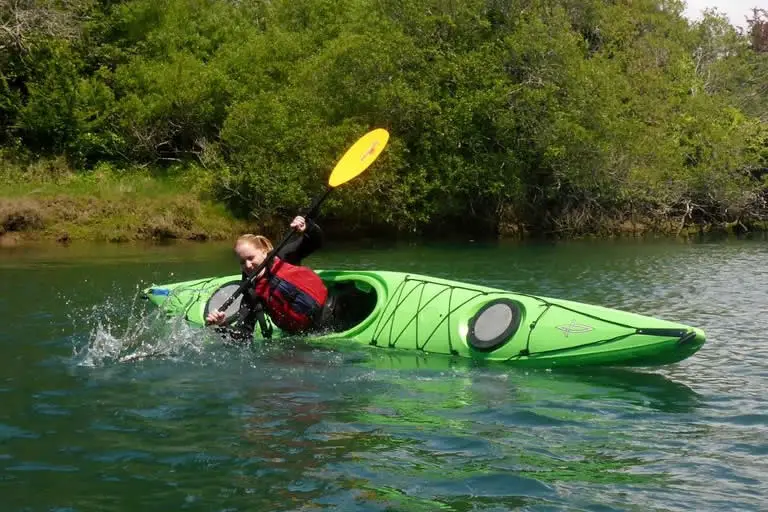Contents
Why Stability Is Key When It Comes To Kayaking
A tippy kayak is no fun to use and a continuous feeling of instability can become demoralizing to a novice.
That’s why a good understanding of kayak stability is essential for gaining the mastery of your vessel.
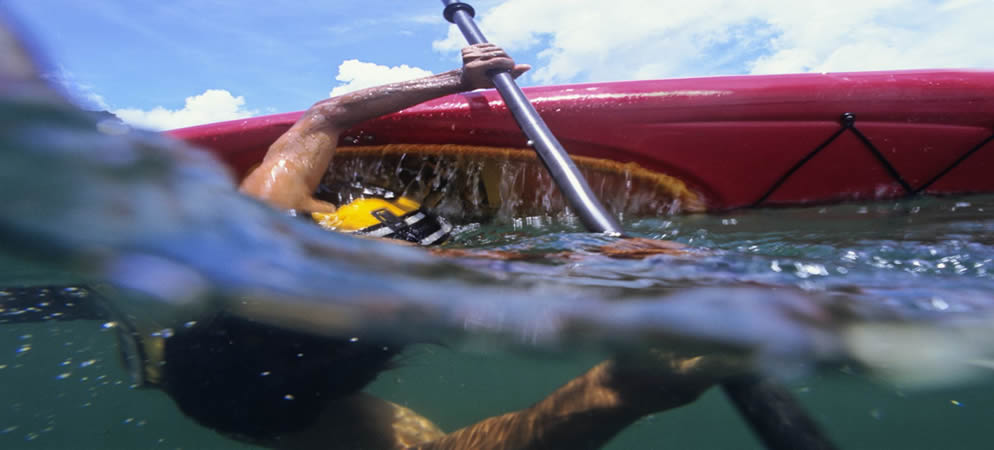
When good stability is a natural part of your paddling you can turn your focus and energies to enjoying your kayaking, rather than trying to maintain an upright position.
In this article, we will run through the key aspects of kayak stability so we can equip you with some strategies and solutions for improving the overall stability of your kayak.
Understanding The 2 Types Of Stability Will Help Solve Your Problem
There are 2 basic types of stability in kayaking.
They are:
- Primary stability.
- Secondary stability.
Primary and secondary stability
“Stability” is essentially a measure of a kayakers ability to stay on top of, or inside, their kayak confidently.
In reality stability comprises a number of elements, the most important of which are:
Primary stability – which covers your ability to move without the kayak accentuating your movement i.e., how stable your kayak is at rest.
Secondary stability – which covers the boat’s ability to correct against leaning i.e., how stable your kayak is when rocked to the side or from side-to-side (by waves for example).
In an ideal world your kayak will have the perfect combination of primary and secondary stability so it delivers great balance on calm water with adequate compensation for your movement and the movement of waves lapping against the hull.
But we don’t live in an ideal world!
Primary stability and secondary stability can be thought of as almost opposite forces; when you improve one the other one suffers.
To understand more about primary and secondary stability read this.
How primary & secondary stability is built into different kayak hull designs
Primary and secondary stability is built into the design of kayaks with some kayaks having better primary stability and some having better secondary stability.
For example, with a recreational flat-bottomed kayak primary stability is preferred over secondary stability because good primary stability means the kayak is stable when at a standstill and while being used in calm water – perfect for beginners and lazy summer day trips on the water.
On the flip side, a whitewater kayak requires better secondary stability because it needs to stay upright when being rocked by rapids.
In the same environment a flat-bottomed kayak, which has poor secondary stability, would struggle and capsize.
Likewise the whitewater kayak would struggle and feel very tippy in calm water and while at a standstill.
Even if you do not fully understand the concepts of primary and secondary stability you will soon see how choosing the wrong kayak for your chosen marine environment will cause stability issues for you.
If you need a better understanding of the key deign characteristics of a kayak and how they affect stability read our article on that that.
5 Factors That Affect Kayak Stability
Understanding the factors that contribute to the stability of a kayak will assist you in selecting the right kayak.
It will also help you to identify the strategies that will help keep you upright in your kayak.
Before I move on to how primary and secondary kayak design will affect your choice of kayak, I will address the 4 factors that contribute to kayak stability.
This information will also help you to understand how to choose a better kayak for your chosen activity and also how to better stabilize your kayak when you are in it.
The main factors that contribute to stability are:
- Width.
- Hull shape.
- Weight distribution.
- The balancing ability of the kayaker.
Obviously the first three factors are design issues.
Any problems that come from these areas can be easily fixed by simply getting the correct kayak type for your purposes (as we covered above).
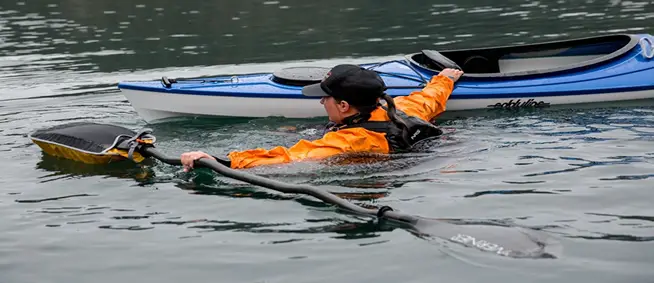
The fourth factor is down to you.
No-one can fix stability issues caused by poor technique except yourself. So, seek expert advice and practice, practice, practice.
Lets look at these four stability factors a bit closer to see how they affect your comfort on the water.
Kayak width
Wider kayaks are more stable and less likely to cause sway and tipping.
Fishing kayaks (sit-on-top kayaks), in particular, are wide enough to allow standing for casting off.
With racing and ocean-going kayaks, width has been balanced by the need for a narrower vessel that cuts through the water and moves smoothly and quickly.
The kayak hull design
The hull design of a kayak has a huge impact on its stability in specific environments.
A flat-bottomed kayak has better primary stability than round-bottomed kayaks.
Though more stable while stationary, flat-bottomed kayaks require more physical effort to move through the water.
The faster round-bottomed kayaks will balance better in challenging waters but will require more physical effort to remain upright when at a standstill.
Weight distribution
For stability in a kayak, the center of gravity is key.
Your load and position in the kayak will greatly affect sway, with higher seating, like that on a sit-on-top kayak, being much more unstable.
Strategies that keep loads lower and centrally located in the boat will greatly improve the stability of the kayak.
The balancing ability of the kayaker
To excel at kayaking, you will need good balancing ability and a strong core.
Your ability to balance in a kayak can be improved with training, practice and improved physical fitness.
Practicing in your kayak in shallow water can help build core strength and improve your basic balancing skills in a relatively safe environment.
Stability issues can be due to using the wrong kayak (sit in vs sit on)
There are also different stability issues that a kayaker can encounter if they are using a sit-in kayak or a sit-on-top kayak.
The reasons for choosing one type of kayak over the other are too far reaching to cover in this article.
If you want to know more about the two different types of deign read our article Sit-in vs Sit-on kayak. A Guide to Picking the Best One for You.
For the remainder of this article we will assume that you are using a sit-in kayak.
Be aware though that some of the advice at the end of the article, such as using outriggers, can be applied to sit-on-top kayaks as well.
The 2 Main Kayak Stability Issues & Their Causes
The above information was given to acquaint you with the general rules of stability of a kayak.
The information below is of more practical use.
It will allow you to quickly identify the cause of your particular kayak instability issue.
You will see that using a kayak that has better primary stability in a manner that is better suited to a kayak with better secondary stability will cause instability and vice versa.
The main cause of instability comes from using a kayak with the wrong type of hull design
There are key stability issues connected to different types of sit-in kayak due to primary and secondary stability designs.
This simply means, if you are using a kayak designed for a different environment from the one you are using it in you will experience substantial stability problems.
There are 6 basic types of kayak that are designed for specific uses.
They are:
- Sea and touring kayaks.
- Recreational flat bottom kayaks.
- River/whitewater kayaks.
- Surf kayaks.
- Racing kayaks.
- Fishing kayaks (sit-on-top kayaks).
If you are using a kayak in an environment for which it was not designed you will encounter stability problems from the outset.
This is because the kayak design will revolve around either better primary stability or better secondary stability when you need the other.
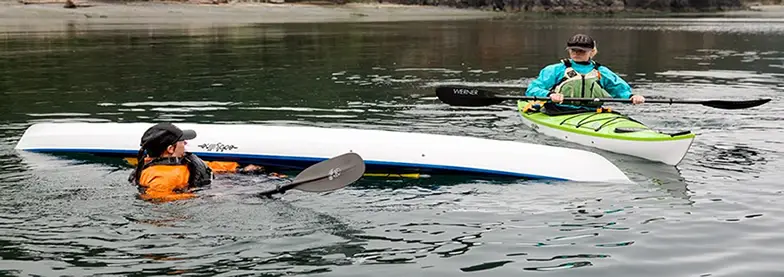
For instance, if you are using a kayak designed to give you better primary stability in an environment where you need better secondary stability you will struggle to stay afloat.
A real world example can be see with ocean-going kayaks. A touring kayak is designed to be used in choppy waters such as the ocean.
If you try to use a recreational flat-bottomed kayak in the same environment you would likely capsize.
Likewise, a whitewater kayak, designed to ride rapids safely without capsizing, when used in calm waters will feel incredibly unstable and very tippy. A flat bottom kayak that has better primary stability would be a better choice in that environment.
Your stability issues could simply be down to the fact that you are using the wrong type of kayak!
To understand if you are using the correct kayak type for your purposes read our article how to find the best sit-in kayak for you.
If you only want a kayak for recreational use read our article why choose a flat bottom kayak.
Both o the above mentioned articles will show you how to pick a kayak with the best stability for your chosen activity.
Stability issues can also be caused by inexperienced paddlers
Kayak stability is not only due to the actual kayak though.
Stability is also a subjective experience.
Stability issues can be due to the inexperience of the kayaker.
Different kayakers can experience varying stability issues, or a complete lack of them, when using the same boat in the same environment depending on their skill level.
Perfecting your technique and getting your basic skills right may solve your stability issues especially when battling against the current.
The less stability a kayak has, the more it will sway. If sway exceeds the tipping point of the kayak, it will flip over or capsize.
It the kayak capsizes it will result in the kayaker being submerged underwater while still in the boat.
This is why one of the basic skills you should learn first is how to roll a kayak.
Stability is is not just about safety and improving your experience on the water though.
Having more stability on the water will also improve the performance and reaction of your boat.
Therefore, it is important to test the limits and tipping point of your vessel, and then improve stability where you can.
5 Kayaking Hacks For Eliminating Kayak Instability
If you find yourself constantly stuck with a tippy kayak, all is not lost.
There are numerous strategies that you can adopt to get to grips with keeping yourself upright.
Here are our top tips:
#1. Choose a kayak that has the right type of design
As you have seen from the information in this article no two kayak types have the same hull design.
By understanding the simple concepts of primary and secondary stability explained above, you will be able to choose the correct kayak for your chosen activity.
In other words, you can easily pick a kayak that has the hull characteristics with the correct mix of primary and secondary stability for your particular purpose.
Using the right type of kayak in an environment for which it was designed will solve about 90% of your stability issues.
#2. Build stability skills
There are 5 skills you can develop that will greatly help you stay stable on the water regardless of what type of kayak you are using.
Practice on your knees.
If balance is an issue, start building your skills by using your kayak slightly differently than normal.
Instead of sitting in the kayak, kneel in it, spreading your knees apart to improve stability.
Learn your tipping point.
Get out on the water (on a warm day) and test the limits of your kayak.
By deliberately tipping your boat you will get to grips with how to correct your kayak and learn the optimum positioning on the boat.
Learn how to roll your kayak.
Knowing how to roll your kayak is a must-have safety skill so you can right yourself should you capsize.
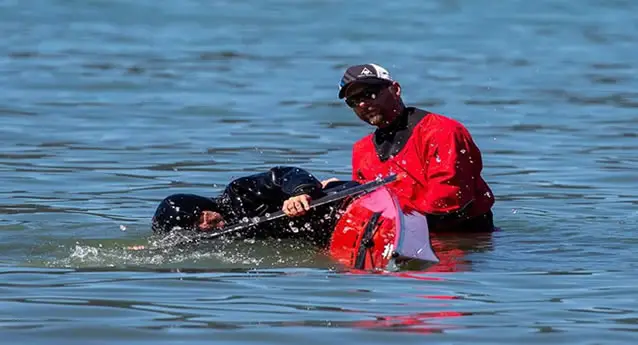
However, learning how to roll will also give you a much better understanding of where your boat’s tipping point is and will greatly help you improve your overall balance.
Watch this video that shows you how to roll a kayak.
Learn how to tilt and hold.
Leaning your kayak on the water so it sits on its side is known as tilt and hold or edging.
Perfecting this exercise will help in building the core strength you need to prevent yourself from falling into the water.
See how to do it in this video.
Reflex low brace.
Knowing how to use this paddle-based maneuver will aid you in correcting a tippy boat while out on the water.
It works to counteract the natural reflexes that would cause you to be more likely to capsize.
Learn how to do it here.
#3. Lower your seating
Keeping your center of gravity low in your kayak will improve stability.
This tip will be more useful for sit-on-top fishing kayaks.
#4. Add ballast
Ballast works to lower the center of gravity in your boat.
Water filled-containers make the best ballast because if the kayak flips, the water adds no extra weight to the vessel because the filled container will simply float.
Add no more than 8 to 12 pounds of ballast for a discernible improvement in the kayak’s stability.
This approach can also help with trimming and tracking.
#5. Attach an outrigger
Here is our top tip for improving your kayak’s stability!
Attach an outrigger kit to your kayak.
Outriggers, also known as kayak stabilizers, are like training wheels for your kayak and add additional buoyancy and stability.
They are pontoon like protrusions that sit each side of your boat to keep the boat totally stable by stopping it tipping from side to side.
This is the easiest and quickest way to instantly improve your stability on the water.
Outrigger kits are very cheap, easy to install and just as easy to remove once you’ve progressed in your paddling skills.
They are also an excellent addition to a child’s kayak for providing extra safety and giving the child more peace of mind while on the water.
Summary: How To Make A Kayak More Stable
Kayaking is all about enjoyment and confidence out on the water, so issues experienced with stability will impact your overall experience in a negative way.
Getting your balance right on the water is not just about improving your experience though.
A lot of energy is used up when you are forced to continually fight to keep yourself stable, leading to fatigue – one of the dangers of kayaking we previously covered.
Get your stability right from the start.
Good stability starts with carefully choosing the right type of kayak for the activity you plan to do and the environment in which you plan to do it.
Wider and flat hulled kayaks are the best choice for a kayaker who finds it difficult to remain stable even on calm water.
Outriggers are by far the easiest way to stabilize your kayak. They are cheap and easy to fit.
Confidence will also be boosted when you know what to do if you flip your kayak by learning how to roll your boat.
As a passing word I’d like to remind you that a PFD is life-saving piece of equipment and should always be worn while kayaking.

